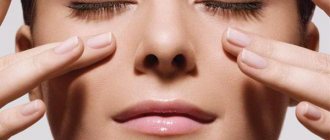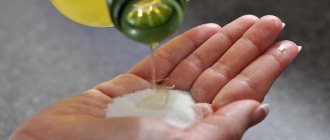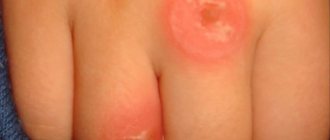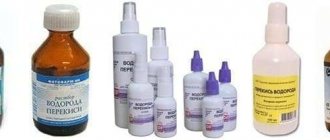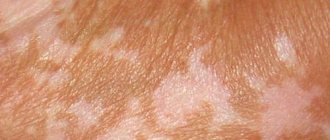Skin dermatitis is a fairly common disease in both children and adults. It can be caused by various reasons and occur in different ways, since there are many varieties of this disease. When preparing complex therapy, various methods can be used, including treatment with folk remedies. Alternative medicine cannot be considered basic, but they complement treatment well. There are many recipes that help relieve the symptoms of the disease.
A folk ointment for dermatitis is prepared based on cranberries.
Folk remedies for the treatment of dermatitis
This therapy uses plants, herbs, vegetables and fruits.
Chatterbox
The composition and method of preparation may vary. For example, for allergic dermatitis, a mixture is used:
- water – 50 ml;
- zinc oxide – 15 g;
- talc – 15 g;
- glycerin – 10 ml.
If the disease is accompanied by severe itching, 5 mg of Diphenhydramine can be added to this mass.
The mash is also prepared based on the following substances:
- distilled water – 30 ml;
- zinc oxide powder – 10 g;
- Anestezin – 1 cube;
- 90% ethyl alcohol – 10 ml;
- white clay – 20 g.
First, the liquid components are mixed, then the bulk ones are added to them. The product is applied only to clean skin. Shake the bottle with the composition before use. In case of mild to moderate severity of the disease, the mash is applied 1-2 times a day, in case of advanced disease - every 4 hours.
Ointments
Such products can be prepared with your own hands from available ingredients. One of them is glycerin ointment. To prepare it you will need 5 ml of milk and glycerin. They are mixed and rice starch is added in such an amount that a mushy mixture is obtained. The resulting ointment is applied to the affected areas before going to bed at night, and washed off in the morning.
Another recipe is a mixture of cranberries and Vaseline. You will need a quarter glass of juice squeezed from fresh berries and 200 g of Vaseline.
Decoctions
It is prepared using oak bark. Pour a tablespoon of dry crushed raw materials into a glass of hot water and put on fire. Boil the mixture over low heat for 15 minutes, cool, and strain. The prepared decoction is used for compresses: a sterile bandage or piece of cloth is moistened in liquid and applied to the affected areas overnight.
You can also prepare a decoction against dermatitis using birch buds. Five st. l of raw materials, pour a glass of boiling water, let it brew in a container under the lid for 15 minutes. Strain and use as compresses. Decoctions relieve irritation, itching and redness of the skin;
Infusions for oral administration
Dermatitis needs to be treated not only from the outside, but also from the inside. Various tinctures with healing ingredients help.
Combine the ingredients: half a teaspoon of lemon juice, 1 teaspoon of crushed chicken egg shell, half a teaspoon of vodka. The finished product is taken one teaspoon 2 times a day.
Nettle tincture. Pour five tablespoons of dry or fresh nettle into 250 ml of boiling water and let cool. Take the product internally. At one time you need to drink half the prepared volume of the medicine. You need to repeat the techniques 3 times a day.
Dandelion tincture. Pour one tablespoon of dandelion leaves into two glasses of boiling water and place in a dark place for 2 hours. Take the cooled product, half a glass, 4 times a day.
Therapeutic baths
Baths with periwinkle are effective. You will need a tablespoon of raw materials and 250 ml of boiling water. Boil everything over low heat for 12 minutes. Then cool the broth, strain, and pour into a bathtub filled with warm water. The duration of the procedure is 15 minutes. After taking a bath, apply the remaining herb from the decoction to the affected areas and leave for a quarter of an hour.
Bath with a combination of chamomile and linden. Mix the raw materials in dry form and pour 5 tablespoons of the resulting mixture into a liter of boiling water. Place on low heat and simmer for 35 minutes. Pour into a warm bath. Take the procedure for 15 minutes.
Lotions
Sage lotion. To prepare it, take 1 teaspoon of leaves and pour a glass of boiling water. Place the mixture on low heat and cook for 5 minutes. Then cover the container with the broth, leave for 30-40 minutes, and filter. The product is used warm as a lotion, moistening a gauze cloth folded in several layers in the infusion.
Attention! Before using any recipes, you must ensure that there are no contraindications for the use of any components.
Preparing mash
You can treat dermatitis at home, but you must follow all the recommendations. A fairly effective substance in eliminating the symptoms of the disease is mash, which you can order at a pharmacy or prepare yourself. In pharmaceuticals it is called Tsindrol. The drug is considered a traditional medicine because it consists of natural ingredients. To prepare such a solution yourself, you must do the following:
- take 40 ml of distilled water and alcohol,
- add 2 ml of anesthetic, novocaine or lidocaine 2%,
- the solution is mixed with 30 grams of white clay and zinc until a homogeneous mixture is obtained.
Before using the mash, it is necessary to thoroughly clean the surface of the damaged areas. For this, various antiseptics are used, including tea tree oil. The mash shakes well, as its components settle to the bottom. Next, it is applied in a thin layer to the affected area, there should be no rubbing movements. The mixture is left for 20 minutes, after which it is lightly rubbed. The product forms a protective film on the surface of the wound. The procedure can be performed up to 4 times a day.
Tsindol can be purchased ready-made at the pharmacy.
The first remedy for dermatitis
A remedy that will help you quickly get rid of dermatitis is vegetable oil. We are talking not only about sunflower, but also from jojoba, coconut and grape seeds.
The value of these products lies in the fact that they prevent skin moisture loss, protect it from allergens and various irritating factors.
Jojoba oil nourishes the epidermis with vitamin E and fatty acids, softens the skin. Coconut replenishes the deficiency of various nutrients in the layers of the skin that are lost due to dermatitis. These are lipids, amino acids and vitamins.
Grapeseed oil moisturizes and nourishes the skin, relieves irritating symptoms.
Causes
In most cases, allergic atopic dermatitis is diagnosed in children under one year of age - at the moment when complementary foods are introduced into the child’s menu. This is where the small organism reacts to a food product that contains an irritant for it. Although the cause of the disease is not only allergenic food. Until now, scientists are trying to come to a consensus about what exactly provokes this pathology. According to generally accepted information, the following factors may be the reasons.
- Nutrition: congenital and acquired disorders of digestive function, improper feeding, early introduction of highly allergenic foods into the diet, intestinal dysbiosis, disruption of the cytoprotective barrier.
- Stress, frequent worries, nervous disorders.
- Poor material and living conditions: constant dampness in the premises, overcrowding (a large number of people in one small area), lack of finances (unbalanced nutrition, lack of proper treatment).
- Tobacco smoke is the so-called passive smoking.
- Meteorological factors: fog, high humidity, rainy weather, any changes in atmospheric pressure.
- Polluted air: exhaust gases, heavy metal salts, chemical suspensions.
- Skin contact with wool, aggressive detergents and chemicals, acrylic, cosmetics.
- Age-related features: increased risk of allergic dermatitis from the first days of life up to 2 years.
- Microorganisms: S.aureus aggravates skin symptoms of the disease.
Since most of these factors appear in a baby’s life from the first days after birth, allergic dermatitis is most often diagnosed in a child under one year old or in preschool age. Parents need to keep in mind the causes of the disease in order to protect their child from such harmful phenomena. If the pathology cannot be avoided, you will have to undergo a course of treatment, which will largely depend on its form.
Origin of name. The medical term “atopy” comes from the Greek “atopos,” which translates as “unusual, alien.”
The effectiveness of tar for dermatitis
Birch tar is used for various skin diseases. It is effective not only for dermatitis, but also for psoriasis, eczema, and allergy symptoms.
The valuable property of this natural product is that it stimulates the process of restoration of new epidermal cells. Tar has the following properties:
- eliminates bacterial microorganisms;
- fights viruses and infections;
- relieves swelling and irritation;
- suppresses itching.
Attention! It is not recommended to lubricate the skin with dermatitis with tar in its pure form. Before use, it should be mixed with animal fat (pork, goose, lamb).
Also, its combination with honey has a good effect. You need to mix 100 g of each component. 2 hours after application, the composition is washed off with chamomile decoction.
Nutritional Features
The main goal of adjusting the diet is to eliminate the possibility of allergens entering the body. At the same time, the body should receive food rich in vitamins and microelements, as well as substances that help improve the functioning of the intestines and liver. The latter experiences an increased degree of stress in atopic dermatitis.
All products are classified according to the degree of allergenicity. It can be high, medium or low. A large amount of a substance that provokes the development of an undesirable reaction is contained in the following foods:
- Chicken.
- Gusyatin.
- Duck.
- Lamb.
- Fatty pork.
- Fish.
- Seafood.
- Salmon caviar.
- Peaches.
- Citrus fruits.
- Cherry.
- Melon.
- Cherry.
- Grenade.
- Persimmon.
- Pumpkin.
- Radishes.
- Carrots.
- Eggplants.
- Beetroot.
- Malina.
- Semolina.
- White bread.
- Pasta.
- Confectionery and butter products.
- Cow's milk.
- Cream.
- Ryazhenka.
- Sour cream.
- Cheese.
- Chocolate.
- Cocoa.
- Honey.
- Chicken eggs.
- Wheat.
In addition, adults suffering from atopic dermatitis are strictly prohibited from drinking alcoholic beverages.
It is recommended to include the following products in the menu:
- Beef.
- Rabbit meat.
- Turkey meat.
- Lean pork.
- Pears and apples are green.
- Plums.
- Gooseberry.
- Cabbage (any kind).
- Turnip.
- Green peas.
- Greenery.
- Zucchini.
- Potato.
- Cucumbers.
- Porridge (buckwheat, pearl barley, oatmeal).
- Dry biscuits and biscuits.
- Bran bread.
- Vegetable oils.
- Low-fat kefir.
Heat treatment of products significantly reduces the degree of allergenicity. In this regard, it is recommended to minimize the consumption of raw vegetables and fruits.
Use of Sophora japonica
Based on this herbal component, an infusion is prepared for oral administration. To do this, crushed Sophora fruits (1 tbsp) are poured with one glass of boiling water and left for 12 hours. The drug is taken orally 0.2 ml once a day.
You can also prepare a remedy for external use from Sophora japonica. Grind 2 tbsp. l of seeds and pour the resulting mixture into 0.5 ml of vodka, leave for 10 days in a dark place, periodically shaking the contents. The finished product is used to wipe problem areas twice a day.
Disease prevention
Compliance with the rules of personal hygiene is the key to health. Under no circumstances should you squeeze acne or comedones, otherwise this will provoke even more inflammation.
We recommend reading: Hyperhidrosis of the armpits, face and palms
You need to wash your hair with shampoo for oily hair, it is advisable to buy it at the pharmacy. Ultraviolet rays, rubbing with solutions of water, alcohol and vitamin A will be good means of preventive measures.
We bring to your attention a video with interesting folk remedies for dermatitis based on bay leaves:
The benefits of tar soap
Dermatitis can be treated at home using tar soap.
This remedy has a pronounced antiseptic effect and gives good results in the treatment of the scalp.
Tar soap improves blood circulation in the affected areas, stimulates skin regeneration processes, reduces inflammation and reduces irritation.
In its pure form it can be used for compresses and baths.
Attention! Tar soap dries the skin, so it can be used on the body 2-3 times a week, and on the scalp - no more than once.
Contraindications
When treating atopic dermatitis with folk remedies, the most important thing is to avoid side effects
When treating atopic dermatitis with folk remedies, it is important to prevent complications. Strong advice is that before using one or another method of treatment, there is a need to check the body for hypersensitivity.
It is done in this way: a very thin layer of the prepared preparation is applied to the bend of the elbow - ointment, decoction or infusion. The treated area must be monitored for 12 hours. If there is no redness, swelling, burning or other side effects at the site of exposure, you can safely use a certain remedy for the treatment of atopic dermatitis.
Folk remedies that are used externally have virtually no harmful effects. Caution should be exercised during pregnancy and the period of natural feeding.
St. John's wort
This plant has a calming effect and reduces the severity of itching and pain.
To prepare the ointment, fresh St. John's wort is crushed and the juice is squeezed out (at least 1 glass). The resulting liquid is put on fire and boiled until the volume is reduced by 2 times. Then the juice is cooled, mixed with butter, in a proportion of 1/4. The resulting composition is lubricated on inflamed areas of the skin 2-3 times a day.
Another recipe based on St. John's wort is oil with the addition of a plant component. Fresh raw materials (25 g) are crushed and 240 ml of vegetable oil is poured into it. The mixture is infused for 15 days, then filtered. The resulting composition is applied to inflamed skin.
Clinical manifestations
The severity of symptoms is individual. However, the following conditions are constant “companions” of atopy:
- Dry skin. The skin most often affected is in the folds, on the elbows, and under the knees. However, atopic dermatitis is often diagnosed on the face and neck.
- Rashes. They may appear as red spots or blisters with exudate.
- Cheilitis. This term refers to inflammation of the oral mucosa. It occurs with atopic dermatitis on the face.
The disease has several forms:
- Erythematous. Characterized by the formation of spots, papules and small scales.
- Lichenoid. Erythemas are large in size. At the same time, they are covered with dense scales.
- Eczematous. This form is characterized by the presence of limited foci of pathology, characterized by increased dryness. Itching in atopic dermatitis of an eczematous nature is unbearable.
Young people often ask their attending physician whether they are being drafted into the army with atopic dermatitis. There are two possible scenarios. If the skin lesions are extensive, they will not be accepted into the army. But first you need to make an appointment with a dermatologist and obtain the appropriate certificate from him. If there is a stable remission (no episodes of exacerbation have occurred for 5 or more years), the young man is fit for military service.
Wine treatment
Famous wine recipes:
- With plantain. Wash 5 fresh plantain leaves and pass through a meat grinder. The resulting mushy mass is added to a container filled three parts with white wine. Use this product to wipe the affected areas.
- With aloe. The crushed 200 g plant is placed in a dark room for 12 days at a temperature not exceeding +6 degrees. Then add 150 g of castor oil and 50 ml of red wine to it and mix everything. The resulting composition is spread on gauze and used as a compress.
Treatment with potato juice
Peeled potato tubers are passed through a meat grinder or grated. The pasty mass is spread on a gauze napkin and fixed with a bandage on the problem area. Due to squeezing, juice is released, which has a beneficial effect on inflamed skin.
Attention! Using folk remedies, you need to make sure that there are no allergic reactions to certain components of the compositions. Such methods are best used as an addition to the main therapy. And if adverse reactions occur, stop using and consult a specialist.
How does the disease manifest itself?
Due to development, dermatitis can be endogenous and exogenous. In the first case, the disease is an inflammatory process that is localized both on the surface and inside the skin cells. The development of inflammation can be triggered by taking medications and foods to which there are allergic reactions. The second variant of the disease has the form of skin inflammation, which appears after exposure to an external irritant. This can be chemicals, mechanical and physical damage. Depending on the form of the disease, the following types of disease are distinguished:
- acute dermatitis – develops as a result of contact with an irritant and disappears after its exclusion,
- subacute – manifests itself in the form of a protracted inflammatory process that can periodically progress and resolve,
- chronic - has a wave-like course and appears mainly upon contact with an irritant.
Like every disease, dermatitis has its own symptoms. Depending on the type of disease, it may differ slightly, but the main negative manifestations include:
- swelling near the lesion site,
- skin redness,
- itching and burning sensation,
- the appearance of papules, plaques or nodules,
- the appearance of bubbles and crusts when they burst,
- increase in body temperature.
Based on what type of disease was diagnosed, a comprehensive treatment is selected, which includes medications and various procedures. You can treat dermatitis at home, but before doing so, you need to consult with a dermatologist who will create individual therapy. Before this, a thorough examination is carried out to find out the cause of the disease.
Dermatitis manifests itself as redness, plaques and nodules

